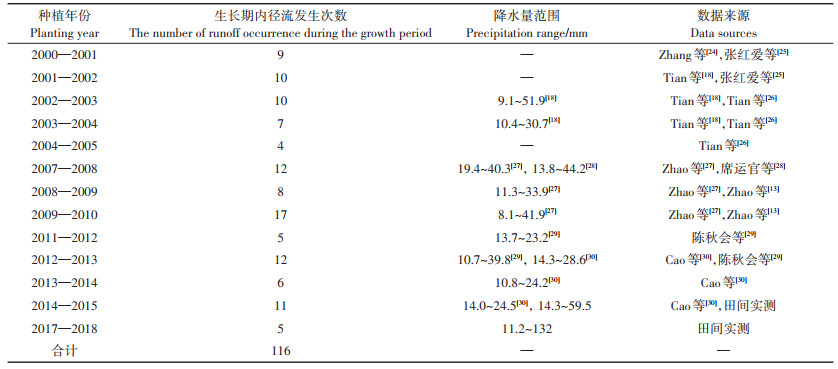2. 江苏省农业科学院农业资源与环境研究所, 农业农村部长江下游平原农业环境重点实验室, 南京 210014
2. Key Lab of Agro-environment in Downstream of Yangtze Plain, Ministry of Agriculture and Rural Affairs, Institute of Agricultural Resources and Environment, Jiangsu Academy of Agricultural Sciences, Nanjing 210014, China
径流是由于超渗产流或蓄满产流两种机制所形成的汇集流水[1]。近年来,随着研究手段的丰富和养分流失过程的定量,较多研究表明径流是农田养分流失的主要途径[2],且受农田耕种条件、降雨量、降雨强度、田间植被覆盖度及土壤水分状况等多种因素综合影响[3]。如,稻田是一种独特的湿地系统,田面在较长时间内需保持一定水层,是在田埂保护下形成的一种封闭径流体系,只有在降雨发生超过田面蓄水高度时田面水才会溢出形成机会径流[4]。坡耕地除地表径流外,壤中流也是其主要流失途径[5],其径流的发生主要受植被覆盖度及坡度影响,植被覆盖度越大、坡度越小,径流延迟效应越强,产流越平稳[6-7]。设施菜地径流则主要集中在揭棚期,其产流的可能性、产流大小在特定的土壤和植被盖度条件下与降雨量呈正相关[8-9]。旱地农田径流发生则受多种因素共同影响[10],其径流的发生与产流量的多少在满足一定降雨强度及土壤含水量条件后还与植被覆盖度及耕作方式有关[11]。这说明,不同类型农田径流发生特征差异较大。因此,对特定农田的田间径流发生特征进行研究有助于明确造成农业面源污染的主要来源,为合理减少农业面源污染提供理论基础。
太湖是我国第三大淡水湖泊,随着该地区农业集约化种植的不断发展和肥料的过量投入,由于农田养分流失而引发的太湖水体污染现状不容乐观[12]。Zhao等[13]监测结果表明,常规施肥下太湖地区稻田和麦田的径流氮素流失量分别达到14.6 kg·hm-2和45 kg·hm-2。而太湖流域是典型的亚热带季风气候,降水丰富、雨热同期,稻麦轮作是本地区主要的种植方式[14]。不同于稻季受梅雨季、台风影响显著,降雨和径流年内分配相对集中[15],麦季降雨发生的随机性更强[16]。此外,太湖地区旱地小麦以雨养灌溉为主,且播种后常需配套丰产沟确保田面无积水,降雨强度超过土壤下渗速率、降雨量超过土壤饱和持水量或强降雨的瞬时冲刷均可能造成径流事件的发生[16]。前人对太湖地区麦季径流发生和流失特征开展了大量研究,但径流发生时间不尽一致。如范宏翔等[17]研究指出麦季径流事件主要在11月至次年2月发生,而Tian等[18]研究发现,麦季径流发生主要集中在11月至次年3月。这也说明短期监测数据由于年际间降水差异而较难对本地区麦田径流发生的时间特征进行定性。
太湖地区小麦一般集中在10月下旬至11月上旬播种,次年5月下旬至6月上旬收获;季节跨度上从上年秋末至次年夏初,不同季别和月份温度变化差异较大[19]。因此,明确麦田径流发生的时间特征对因时因地确定径流养分削减方案更有针对性和指导意义。文献检索发现,侯朋福等[4]结合历史气象数据与定位试验观测数据对太湖地区稻田径流易发期进行了定性分析,但麦田鲜见相关报道。本研究拟通过太湖典型区域历史降水资料和径流发生时间的文献统计结果分析,明确太湖地区雨养麦田的径流发生时间特征,以期为该地区农业面源污染削减方案的制定提供科学依据。
1 材料与方法 1.1 历史降水资料的时序变化分析选取太湖流域典型地区(苏州、无锡、溧阳、湖州)(图 1)1956—2015年60 a间逐日降水数据(国家气象信息中心),对60 a的年降水量和麦季降水量进行整合分析,并分析了年降水量距平百分率。选择降水距平百分率正常年份,依据小麦生长周期以月为统计区间分别统计区间内降水频次(天数)、累积降水量,折算降水概率(降水频次除以区间天数)和日均降水量(累积降水量除以降水频次)。
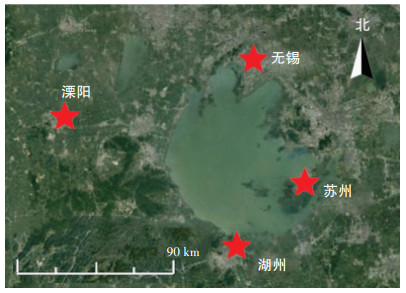
|
图 1 气象监测点位分布 Figure 1 Meteorological station sites |
选择Web of Science和中国知网数据库,检索关键词设置为“wheat”&“runoff”&“China”(Web of Science数据库)和“小麦”&“径流”(中国知网数据库),对目标文献进行初步收集。文献收集后,选择太湖地区相关文献并剔除无径流发生时间统计和相同作者在同一田块相同监测年份的文献后对太湖地区不同年份径流发生时间进行分析。依据小麦生长周期以月为统计区间分别统计区间内径流频次(天数)并折算径流发生概率(径流频次除以区间天数)。此外,依据文献内有记录的降水资料,对不同年份驱动径流发生的降水范围进行统计。
1.3 统计分析方法距平[20]是时间系列中某一个数值与平均值的差,分正距平和负距平,距平百分率是对距平进行的标准化处理。因其能够更加直观地反映数值的变化,被广泛运用于气象研究。
降水距平百分率反映了某一年降水量与多年平均状态的偏离程度,能体现降水量年际变化的程度及其变化过程的波动性,常被用来代表某年降水值较常年降水值的偏多偏少[21-22]。距平百分率的计算见公式(1)。

|
(1) |
式中:Pi为某年的降水量,mm;P为多年平均值,mm。

|
(2) |
式中:Pi为某年的降水量,mm;n=60,即1956—2015年60 a历史降水数据。
根据叶瑾琳等[23]引用的国际标准,利用降水距平百分率划分的等级为:当P≥50%,为涝;25% < P < 50%,为偏涝;-25%≤P≤25%,为正常;-50% < P < -25%,为偏旱;P≤-50%,为旱。
常规数据处理和作图在Excel 2007中进行。
2 结果与分析 2.1 基于历史气象资料的降水发生时间特征 2.1.1 降水量统计及距平分析图 2为1956—2015年60 a间太湖典型地区(苏州、无锡、溧阳、湖州)历史降水量及麦季降水量数据整合分析。由图可知,近60 a太湖地区年降水量在657.7~1 643.7 mm,年均降水量为1 164.8 mm,年际之间呈现小幅波动趋势。小麦生长季(11月至次年5月)降水量约在207.3~742.8 mm,平均降水量均值为514.6 mm。麦季降水量占全年降水量比值为44.8%(20.5%~66.5%)。
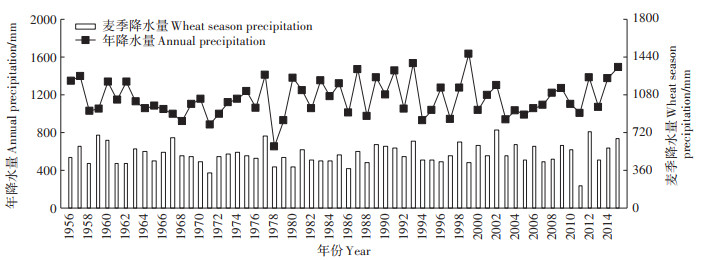
|
图 2 60 a太湖典型地区年降水量和麦季降水量(1956—2015年) Figure 2 Annual precipitation and wheat season precipitation in the Tai-lake region in 60 years(1956—2015) |
年降水量距平百分率P结果表明,太湖地区降水量年际之间呈现出一定的波动性,除1987、1991、1993、1999、2015年为偏涝年,1978为偏旱年,其余年份均为正常年份,年降水距平百分率基本在±25%左右变化(正常)(图 3)。因此、剔除偏涝年(1987、1991、1993、1999、2015年)和偏旱年(1978年)后,对本地区降水的时间特征分析有一定的代表性。
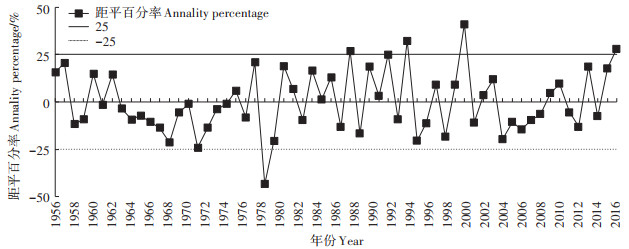
|
图 3 60 a太湖典型地区年降水量距平图 Figure 3 Annual precipitation anomaly percentage of the Tai-lake region in 60 years |
图 4所示为剔除偏涝年、偏旱年按月进行时序划分的日均降水概率以及日均降水量统计结果。结果表明,小麦生长季降水概率的时序变化呈现先下降后上升的趋势。降水概率最低月份出现在12月,为25.2%,其余月份降水概率分别为27.1%(11月)、30.5%(1月)、36.2%(2月)、41.4%(3月)、43.0%(4月)、40.6%(5月)。不同月份降水概率表现为4月>3月>5月>2月>1月>11月>12月。
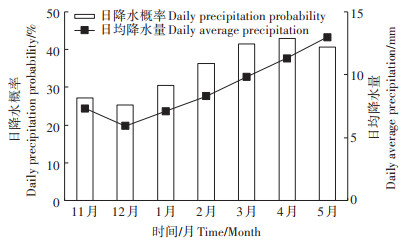
|
数据不包括1987、1991、1993、1999、2015年(偏涝年)和1978年(偏旱年) The data does not include 1987, 1991, 1993, 1999, 2015(flood year)and 1978(dry year) 图 4 60 a小麦生长季内日降水概率、日均降水量时序变化(1956—2015年) Figure 4 Daily precipitation probability during the 60-year wheat growing season and temporal variation of daily precipitation(1956—2015) |
此外,日均降水量结果表明,按月划分的日均降水量时序变化同样表现为先下降后上升的趋势(图 4)。日均降水量最低月份为12月(5.94 mm),最高月份为5月(13.00 mm)。不同月份日均降水量表现为5月>4月>3月>2月>11月>1月>12月。
2.2 实际径流发生频次及降水范围统计表 1为对太湖流域文献结合田间实测进行统计获得的多年径流事件发生频次及降水范围。从表中可以看出,2000—2018年共18季小麦种植,文献检索到的数据涵盖13季,除2014—2015年处于偏涝年,其余监测年份均为正常年份。小麦生长季径流发生次数统计结果表明,在13个小麦生长季内,共发生116次径流事件,年发生次数均值为8.9。此外,生长季内径流发生次数比较结果表明,径流发生次数最多生长季为2009—2010年,最少生长季为2004—2005年。此外,有记录降水范围结果表明太湖地区麦季驱动径流发生的最小降水量为8.1 mm(2009—2010年);最大降水量为132 mm(2017—2018年)。不同年份驱动径流发生的最小降水量范围为8.1~19.4 mm。
|
|
表 1 太湖地区多年径流事件统计表 Table 1 Statistical table of annual runoff events in Tai-lake region |
扣除偏涝年(2014—2015年)后,12年小麦生长季按月进行时序分析的径流发生次数占比结果列于图 5。结果表明,2月(20次)和3月(19次)的径流发生次数明显高于其他月份,各占总次数的19.05%和18.10%。12月(17次)、4月(14次)和5月(16次)径流发生次数的占比相当,分别为16.19%、13.33%和15.24%。此外,11月(7次)和1月(12次)径流发生次数占比较低,分别为6.67%和11.43%。结果说明,2月和3月是径流发生的高风险期,12月、4月和5月是次高风险期。
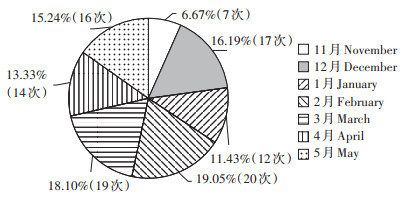
|
图 5 太湖流域多年月份径流次数占比图 Figure 5 Percentage of runoff in the Tai-lake basin for 13 years |
农田径流的发生具有随机性,但在特定的条件如降水、土壤含水量、田间植被覆盖度等因素影响下,农田径流又呈现出一定的规律性[31]。由于降水为农田径流发生的主要驱动力[29]且田间土壤条件时空及年际差异较大不易测定,因此本文统计太湖流域典型地区60 a历史降水时序变化和田间径流实际发生时间规律,分析小麦生长季内径流风险期。当前,有学者基于降水的前提,对农田径流的发生规律进行研究。侯朋福等[4]对太湖流域稻田进行研究,得出基肥期和蘖肥期为水稻径流易发期。宁建凤等[32]对广州典型稻田进行研究,得出早稻季为当地径流发生的主要时期。汪亚及等[33]研究发现雨季为红壤农田氮素流失的高发期。然而,与稻田持续淹水特性不同,麦田土壤全生育期处于无水层状态,更易受植被冠层和土壤含水量等因素影响。因此,麦田径流的研究多集中于小麦径流养分的流失总量及流失浓度[18, 25, 27, 30],对于通过数据统计方法获得麦季径流发生高风险时段的研究较少。
本研究通过对太湖流域典型地区1956—2015年历史降水数据分析发现,除少数偏涝年及偏旱年外,其余年份基本在±25%(正常)之间波动。因此,剔除偏旱年及偏涝年后进行的降水发生时间特征分析具有一定的代表性。多年小麦生长季内(剔除偏旱年及偏涝年)按月度时序划分的日降水概率及日均降水量都呈现先下降后上升的趋势。日降水概率和日均降水量最低月份皆为12月,随后日降水概率与日均降水量皆随时序的递增而增加。这与万晓凌等[15]分析太湖流域降水月分配变化所得到的结论一致。但田间径流的发生除受降水影响,还与田间土壤水分状况、土壤下渗速率及地上部群体覆盖度等因素密切相关。对太湖地区有降水记录的径流发生统计结果表明,不同年份驱动径流发生的实际最小降水量为8.1~ 19.4 mm,有一定波动性。因此,有必要结合多年份田间径流实际发生时间对太湖地区雨养麦田径流发生时间特征进行分析。
本研究通过对2000—2018年共18季小麦种植年中有记录的12季(不含偏涝年)小麦径流实际发生时间数据分析,发现小麦径流发生时间与降水概率和日均降水量并不完全一致,2月和3月是径流发生的高风险期,12月、4月和5月是次高风险期。这与俞映倞等[34]在太湖地区稻麦轮作农田进行的实测研究所监测到的径流发生频次较为一致。王静等[35]在巢湖流域麦田的径流实测研究时所记录的径流发生次数也多集中于2、3月。郑少文等[8]在太湖流域菜地的径流实测研究时也发现冬春茬蔬菜生长期内径流多发生于2、3月。小麦径流发生时间与降水概率和日均降水量并不完全一致的现象可能与小麦生长动态(群体覆盖度)和土壤含水量等因素有关。2月和3月小麦分别处于越冬期和返青期,此阶段小麦由于外界温度较低而生长缓慢,植株较小[36]。尽管后期温度略有回升使得小麦新生叶片逐渐伸出叶鞘,但其整体植被覆盖度并未显著提高。因此,尽管2月和3月降水频次和日均降水量低于后期,但由于群体盖度较小[37],对降水的拦截能力较小,径流发生风险较高[38]。4月和5月小麦分别处于拔节期和抽穗开花期。小麦在该时期生长旺盛,茎秆伸长,叶片逐渐展开导致其对降雨的截流量增大[39]。同时,该时期温度回升使植株蒸腾作用变强,株间土壤蒸发量变大,耗水量加剧[40]。但与其他月份相比,4月份和5月份降水概率和日均降水量均较高。其中4月降水概率明显高于其他月份,而5月日均降水量也明显高于其他月份。因此,尽管4月和5月小麦群体盖度较大[41]及温度升高引起的土壤蓄水能力增强[42],但径流发生风险仍较高。11月小麦播种后,由于种子萌发需水[36],真叶生长耗水,同时受土壤裸露蒸发[43]和土壤翻耕等因素影响,土壤含水量较低而蓄水能力较强,因此11月径流发生风险较低。与11月相比,12月降水概率和日均降水量较低,但径流发生风险较高。这可能与此时气温逐渐降低,作物日耗水量减少[44],及11月降水引起的高土壤含水量所导致的叠加效应有关。较多研究表明土壤前期含水量会对径流事件的发生产生影响[45-46],土壤前期含水量较高则更易发生径流[10],因此尽管12月降雨量和降雨概率均不高,但其径流发生风险较高。
4 结论(1)2月和3月是太湖地区雨养麦田径流发生高风险期,12月、4月和5月是次高风险。
(2)驱动径流发生的最小降水量范围为8.1~19.4 mm,径流发生时间特征与降水概率和日均降水量并不完全一致。除小麦生长后期的高降水概率和日均降水量增加了麦田径流发生风险,前期的降水累加效应同样增加了12月麦田径流发生风险。
| [1] |
Xie Z H, Su F G, Liang X, et al. Applications of a surface runoff model with horton and dunne runoff for VIC[J]. Advances in Atmospheric Sciences, 2003, 20(2): 165-172. DOI:10.1007/s00376-003-0001-z |
| [2] |
Owens L B, Shipitalo M J, Bonta J V. Water quality response times to pasture management changes in small and large watersheds[J]. Soil and Water Conservation, 2008, 63(5): 292-299. DOI:10.2489/jswc.63.5.292 |
| [3] |
焦瑞锋, 张鸿睿, 卞新民. 稻田降雨径流扰动系数的解析分析[J]. 浙江农业学报, 2012, 24(5): 898-903. JIAO Rui-feng, ZHANG Hong-rui, BIAN Xin-min. Analytical analysis of paddy runoff disturbance coefficient[J]. Acta Agriculturae Zhejiangensis, 2012, 24(5): 898-903. DOI:10.3969/j.issn.1004-1524.2012.05.027 |
| [4] |
侯朋福, 薛利祥, 俞映倞, 等. 稻田径流易发期不同类型肥料的氮素流失风险[J]. 农业环境科学学报, 2017, 36(7): 1353-1361. HOU Peng-fu, XUE Li-xiang, YU Ying-liang, et al. Nitrogen loss risk of paddy field under different fertilizations in runoff prone period[J]. Journal of Agro-Environment Science, 2017, 36(7): 1353-1361. |
| [5] |
王双, 叶良惠, 郑子成, 等. 玉米成熟期黄壤坡耕地径流及其氮素流失特征研究[J]. 水土保持学报, 2018, 32(6): 28-33. WANG Shuang, YE Liang-hui, ZHENG Zi-cheng, et al. Characteristic of runoff and nitrogen losses in yellow soil sloping cropland at mature stage of maize[J]. Journal of Soil and Water Conservation, 2018, 32(6): 28-33. |
| [6] |
Ma B, Li C D, Li Z B, et al. Effects of crops on runoff and soil loss on sloping farmland under simulated rainfall[J]. Clean Soil Air Water, 2016, 44(7): 1-9. |
| [7] |
Lin Q T, Xu Q, Wu F Q, et al. Effects of wheat in regulating runoff and sediment on different slope gradients and under different rainfall intensities[J]. Catena, 2019, 183: 104196. DOI:10.1016/j.catena.2019.104196 |
| [8] |
郑少文, 郭智, 王子臣, 等. 太湖流域典型蔬菜地氮素径流流失特征[J]. 水土保持学报, 2014, 28(3): 204-208. ZHENG Shao-wen, GUO Zhi, WANG Zi-chen, et al. Characteristic of nitrogen losses by surface runoff in the typical vegetable field of Taihu Lake basin[J]. Journal of Soil and Water Conservation, 2014, 28(3): 204-208. |
| [9] |
黄丽华, 沈根祥, 钱晓雍, 等. 砂质梨园和蔬菜地氮素流失及其影响因素研究[J]. 农业环境科学学报, 2008, 27(2): 687-691. HUANG Li-hua, SHEN Gen-xiang, QIAN Xiao-yong, et al. Nitrogen loss in sandy pear orchard and vegetable field and impact factors[J]. Journal of Agro-Environment Science, 2008, 27(2): 687-691. DOI:10.3321/j.issn:1672-2043.2008.02.052 |
| [10] |
Liu R M, Wang J W, Shi J H, et al. Runoff characteristics and nutrient loss mechanism from plain farmland under simulated rainfall conditions[J]. Science of the Total Environment, 2014, 468/469: 1069-1077. DOI:10.1016/j.scitotenv.2013.09.035 |
| [11] |
王心星, 荣湘民, 张玉平, 等. 玉米与不同作物间套作条件下旱地径流的磷损失特征[J]. 水土保持学报, 2015, 29(4): 97-103, 164. WANG Xin-xing, RONG Xiang-min, ZHANG Yu-ping, et al. Characteristic of phosphorus loss in dry land runoff under different intercropping modes of maize and different crops[J]. Journal of Soil and Water Conservation, 2015, 29(4): 97-103, 164. |
| [12] |
Netusil N R, Braden J B. Transaction costs and sequential bargaining in transferable discharge permit markets[J]. Environmental Management, 2001, 61(3): 253-262. |
| [13] |
Zhao X, Zhou Y, Wang S Q, et al. Nitrogen balance in a highly fertilized rice-wheat double-cropping system in southern China[J]. Soil Science Socirty of America Journal, 2012, 76(3): 1068-1078. DOI:10.2136/sssaj2011.0236 |
| [14] |
蒋孝松, 刘彩玲, 隋标. 太湖流域稻麦轮作体系施肥现状分析与对策[J]. 中国农学通报, 2012, 28(15): 15-18. JIANG Xiao-song, LIU Cai-ling, SUI Biao. Problems and proposals of the current fertilization situation in the rice-wheat rotation systemin Tai Lake basin[J]. Chinese Agricultural Science Bulletin, 2012, 28(15): 15-18. |
| [15] |
万晓凌, 毛晓文. 江苏太湖流域降雨径流年际变化分析[J]. 水资源与水工程学报, 2013, 24(6): 203-205, 210. WAN Xiao-ling, MAO Xiao-wen. Analysis of interannual variations of rainfall runoff Jiangsu Taihu Lake basin[J]. Journal of Water Resources & Water Engineering, 2013, 24(6): 203-205, 210. |
| [16] |
冯国禄, 龚军慧. 人工降雨对稻田中氮磷动态变化的影响研究[J]. 水土保持学报, 2011, 25(2): 130-133. FENG Guo-lu, GONG Jun-hui. Effects of artificial rainfall on dynamics of nitrogen and phosphorus in paddy field[J]. Journal of Soil and Water Conservation, 2011, 25(2): 130-133. |
| [17] |
范宏翔, 徐力刚, 赵旭, 等. 太湖流域典型稻麦轮作农田区氮素流失过程研究[J]. 生态环境学报, 2015, 24(2): 255-262. FAN Hong-xiang, XU Li-gang, ZHAO Xu, et al. Study on nitrogen loss in rice-wheat rotation farmland in Taihu Basin[J]. Ecology and Environmental Sciences, 2015, 24(2): 255-262. |
| [18] |
Tian Y H, Yin B, Yang L Z, et al. Nitrogen runoff and leaching losses during rice-wheat rotations in Taihu Lake Region, China[J]. Pedosphere, 2007, 17(4): 445-456. DOI:10.1016/S1002-0160(07)60054-X |
| [19] |
赵广才. 中国小麦种植区划研究(一)[J]. 麦类作物学报, 2010, 30(5): 886-895. ZHAO Guang-cai. Study on Chinese wheat planting regionalization (Ⅰ)[J]. Journal of Triticeae Crops, 2010, 30(5): 886-895. |
| [20] |
韦开, 王全九, 周蓓蓓, 等. 基于降水距平百分率的陕西省干旱时空分布特征[J]. 水土保持学报, 2017, 31(1): 318-322. WEI Kai, WANG Quan-jiu, ZHOU Bei-bei, et al. Analysis drought characteristics in Shaanxi Province based on precipitation anomaly percentage[J]. Journal of Soil and Water Conservation, 2017, 31(1): 318-322. |
| [21] |
Xu X H, Lv Z Q, Zhou X Y, et al. Drought prediction and sustainable development of the ecological environment, China[J]. Enviromental Science and Pollution Research, 2016, 24(35): 26974-26982. |
| [22] |
黄晚华, 隋月, 杨晓光, 等. 气候变化背景下中国南方地区季节性干旱特征与适应. Ⅲ.基于降水量距平百分率的南方地区季节性干旱时空特征[J]. 应用生态学报, 2013, 24(2): 397-406. HUANG Wan-hua, SUI Yue, YANG Xiao-guang, et al. Characteristics and adaptation of seasonal drought in southern China under the background of climate change. Ⅲ. Spatiotemporal characteristics of seasonal drought in southern China based on the percentage of precipitation anomalies[J]. Chinese Journal of Applied Ecology, 2013, 24(2): 397-406. |
| [23] |
叶瑾琳, 王绍武.近百年全球降水变化[C]//85-913项目12课题论文编委会.气候变化规律及其数值模拟研究论文.北京: 气象出版社, 1996: 23-35. YE Jin-lin, WANG Shao-wu. Global precipitation changes in the last 100 years[C]//85-913 Project 12 Thesis Editorial Board. Climate change law and numerical simulation research papers. Beijing: China Meteorological Press, 1996: 23-35. |
| [24] |
Zhang H C, Cao Z H, Wang G P, et al. Winter runoff losses of phosphorus from paddy soils in the Taihu Lake region of South China[J]. Chemosphere, 2003, 52(9): 1461-1466. DOI:10.1016/S0045-6535(03)00483-1 |
| [25] |
张红爱, 张焕朝, 钟萍. 太湖地区典型水稻土稻麦轮作地表径流中磷的变动规律[J]. 生态科学, 2008, 27(1): 17-23. ZHANG Hong-ai, ZHANG Huan-chao, ZHONG Ping. Study on phosphorus concentrations in runoff from paddy soils of rice-wheat double cropping system in Taihu Lake region[J]. Ecological Science, 2008, 27(1): 17-23. DOI:10.3969/j.issn.1008-8873.2008.01.004 |
| [26] |
Tian Y H, Yang L Z, Yin B, et al. Wet deposition N and its runoff flow during wheat seasons in the Tai Lake region, China[J]. Agriculture, Ecosystems and Environment, 2011, 141(1/2): 224-229. |
| [27] |
Zhao X, Zhou Y, Min J, et al. Nitrogen runoff dominates water nitrogen pollution from rice-wheat rotation in the Taihu Lake region of China[J]. Agriculture, Ecosystems and Environment, 2012, 156: 1-11. DOI:10.1016/j.agee.2012.04.024 |
| [28] |
席运官, 陈瑞冰, 徐欣, 等. 太湖地区麦季氮磷径流流失规律与控制对策研究[J]. 江西农业学报, 2010, 22(5): 106-109. XI Yun-guan, CHEN Rui-bing, XU Xin, et al. Study on N, P loss through runoff in wheat field of Tai Lake Region and counter measures[J]. Acta Agriculturae Jiangxi, 2010, 22(5): 106-109. DOI:10.3969/j.issn.1001-8581.2010.05.035 |
| [29] |
陈秋会, 席运官, 王磊, 等. 太湖地区稻麦轮作农田有机和常规种植模式下氮磷径流流失特征研究[J]. 农业环境科学学报, 2016, 35(8): 1550-1558. CHEN Qiu-hui, XI Yun-guan, WANG Lei, et al. Characteristics of nitrogen and phosphorus runoff losses in organic and conventional rice-wheat rotation farmland in Taihu Lake region[J]. Journal of Agro-Environment Science, 2016, 35(8): 1550-1558. |
| [30] |
Cao Y S, Sun H F, Liu Y Q, et al. Reducing N losses through surface runoff from rice-wheat rotation by improving fertilizer management[J]. Environmental Science and Pollution Research, 2017, 24(5): 4841-4850. DOI:10.1007/s11356-016-8191-y |
| [31] |
郭智, 周炜, 陈留根, 等. 氮肥运筹和少免耕对麦田氮素径流流失的影响[J]. 生态环境学报, 2011, 20(8/9): 1253-1258. GUO Zhi, ZHOU Wei, CHEN Liu-gen, et al. Effects of nitrogen fertilizer application and no tillage on nitrogen loss by surface runoff during the wheat growing season in intensive rice-wheat rotation field[J]. Ecology and Environmental Sciences, 2011, 20(8/9): 1253-1258. |
| [32] |
宁建凤, 姚建武, 艾绍英, 等. 广东典型稻田系统磷素径流流失特征[J]. 农业资源与环境学报, 2018, 35(3): 257-268. NING Jian-feng, YAO Jian-wu, AI Shao-ying, et al. Characteristics of phosphorus runoff losses from typical paddy fields in Guangdong Province, China[J]. Journal of Agricultural Resources and Environment, 2018, 35(3): 257-268. |
| [33] |
汪亚及, 高磊, 彭新华. 红壤农田小流域径流组分对氮素流失动态的影响[J]. 中国科学:地球科学, 2019, 1-14. WANG Ya-ji, GAO Lei, PENG Xin-hua. Hydrologic separation and their contributions to N loss in an agricultural catchment in hilly red soil region[J]. Science China Earth Sciences, 2019, 1-14. |
| [34] |
俞映倞, 薛利红, 杨林章. 太湖地区稻麦轮作系统不同氮肥管理模式对麦季氮素利用与流失的影响研究[J]. 农业环境科学学报, 2011, 30(12): 2475-2482. YU Ying-liang, XUE Li-hong, YANG Lin-zhang. Nitrogen use efficiency and loss from runoff and leaching in wheat season with ricewheat rotation system under different nitrogen management methods in Taihu Lake region, China[J]. Journal of Agro-Environment Science, 2011, 30(12): 2475-2482. |
| [35] |
王静, 郭熙盛, 王允青, 等. 巢湖流域不同耕作和施肥方式下农田养分径流流失特征[J]. 水土保持学报, 2012, 26(1): 6-11. WANG Jing, GUO Xi-sheng, WANG Yun-qing, et al. Characteristics of nutrient runoff losses from farmland under different tillage and fertilization methods in Chaohu Lake region[J]. Journal of Soil and Water Conservation, 2012, 26(1): 6-11. |
| [36] |
胡立勇. 作物栽培学[M]. 北京: 高等教育出版社, 2019: 170-188. HU Li-yong. Crop cultivation[M]. Beijing: Higher Education Press, 2019: 170-188. |
| [37] |
刘峻明, 李曼曼, 王鹏新, 等. 基于LAI时间序列重构数据的冬小麦物候监测[J]. 农业工程学报, 2013, 29(19): 120-129. LIU Jun-ming, LI Man-man, WANG Peng-xin, et al. Monitoring of phenology by reconstructing LAI time series data for winter wheat[J]. Transactions of the CSAE, 2013, 29(19): 120-129. DOI:10.3969/j.issn.1002-6819.2013.19.015 |
| [38] |
刘战东, 高阳, 段爱旺, 等. 麦田降雨产流过程的影响因素[J]. 水土保持学报, 2012, 26(2): 38-44. LIU Zhan-dong, GAO Yang, DUAN Ai-wang, et al. Influence factors of rainfall runoff in the winter wheat field[J]. Journal of Soil and Water Conservation, 2012, 26(2): 38-44. |
| [39] |
王庆改, 康跃虎, 刘海军. 冬小麦冠层截留及其消散过程[J]. 干旱地区农业研究, 2005, 23(1): 3-8. WANG Qing-gai, KANG Yue-hu, LIU Hai-jun. Canopy interception and its dissipation of winter wheat[J]. Agricultural Research in the Arid Areas, 2005, 23(1): 3-8. DOI:10.3321/j.issn:1000-7601.2005.01.002 |
| [40] |
Kong F, Cai W, Shi L, et al. The Characteristics of annual water consumption for winter wheat and summer maize in North China Plain[J]. Procedia Engineering, 2012, 28(5): 376-381. |
| [41] |
王迪, 李久生, 饶敏杰. 喷灌冬小麦冠层截留试验研究[J]. 中国农业科学, 2006, 39(9): 1859-1864. WANG Di, LI Jiu-sheng, RAO Min-jie. Winter wheat canopy interception under sprinkler irrigation[J]. Scientia Agricultura Sinica, 2006, 39(9): 1859-1864. DOI:10.3321/j.issn:0578-1752.2006.09.019 |
| [42] |
刘增进, 李宝萍, 李远华, 等. 冬小麦水分利用效率与最优灌溉制度的研究[J]. 农业工程学报, 2004, 20(4): 58-63. LIU Zeng-jin, LI Bao-ping, LI Yuan-hua, et al. Research on the water use efficiency and optimal irrigation schedule of the winter wheat[J]. Transactions of the CSAE, 2004, 20(4): 58-63. |
| [43] |
王红光.灌溉和雨养条件下高产小麦耗水特性和产量形成的生理基础[D].泰安: 山东农业大学, 2012. WANG Hong-guang. Water consumption characteristics and physiological basis of yield formation in high yield wheat under irrigation and rain-fed conditions[D]. Tai'an: Shandong Agricultural University, 2012. |
| [44] |
王和洲, 孟兆江, 庞鸿宾, 等. 小麦节水高产的土壤水分调控标准研究[J]. 灌溉排水, 1999, 18(1): 14-17. WANG He-zhou, MENG Zhao-jiang, PANG Hong-bin, et al. Study on soil moisture criteria for irrigation in winter wheat[J]. Guangai Paishui, 1999, 18(1): 14-17. |
| [45] |
Li J Y, Zhang F B, Wang S W, et al. Combined influences of wheatseedling cover and antecedent soilmoisture on sheet erosion in smallflumes[J]. Soil & Tillage Research, 2015, 151: 1-8. DOI:10.1016/j.still.2015.02.006 |
| [46] |
Wei L H, Zhang B, Wang M Z, et al. Effects of antecedent soil moisture on runoff and soil erosion in alley cropping systems[J]. Agricultuer Water Management, 2007, 94(1/2/3): 54-62. DOI:10.1016/j.agwat.2007.08.007 |
 2020, Vol. 39
2020, Vol. 39



